Fat deposition and fatty acids in broiler chicks fattened to higher weights
The effect of sex, age and live weight (1) –on the fat deposition and fatty acids in broiler chicks fattened to higher weights.
Published: October 1, 2012
By: Mostafa Elsabbagh, Animal Production Department, College of Agriculture/Lebanese University
The main goal of this experiment was to test the effect of sex, age and live weight of male and female broilers fattening to a high live weights on the quantity and quality of fats and its fatty acid content from nutritional point of view.
In an experiment with 200 male and 130 female hybrid broiler chickens ROSS 208 fed on a litter ad libtum for 9 and 16 weeks for the females and males respectively, with a mash starter BR1 of 12.58 MJ and 86% dry matter in 1 kg, to 26 days of age and ½ mash and ½ granular of 12.80 MJ to the end of the experiment. It was found that the fat percentages in males and females were significantly (P + 0.01) Affected by age ,as age advanced the abdominal fat % increased dailyyby0.07072 and 0.09378
For male and female broilers. Also found that age affected significantly (P+ 0.05-0.01) the Palmitic, Stearic and Oleic acids and the ratio between the unsaturated: saturated fatty acids in abdominal fat for males and Palmitic, Oleic acids and the ratio unsat: sat fatty acids in abdominal fat in females.
Live weight highly significantly (P + 0.01) affected the Palmitic, Stearic,Oleic acids and the ratio unsat:sat fatty acids in abdominal fat in males and the Palmitic, Linoleic and the ratio unsat:sat fatty acids in females ( P + 0.05 -0.01).
Quality of fat was expressed by the ratio of unsaturated: saturated, the unsaturated fatty acids from the nutritional point of view are more qualitative than the saturated ones, the more the unsaturated ones in the fat content the more valuable the product.
From point of storage saturated fatty acids are preferable, male broilers are better for storage because of the decrease in the ratio unsaturated: saturated fatty acids with age from 1.78 at 5 weeks to 1.69 at 9 weeks. From nutritional point of view females are better because of the increase in unsaturated fatty acids with age.
Review of literature:
In broilers, fat is the most variable body component (Lohman 1973)and there is a significant correlation between the body fat and weight of abdominal fat what suggest that the weight of the fat pad is useful indicator of body fatness (Lin 1981). The fat deposition of broiler chicken can be influenced by a variety of factors such as breed, strain ,nutrition ,system of rearing, environmental temperature, sex and age (Kubena 1977). Both the number and size of the fat cells are variable and related to the amount of fat deposited (March and Hansen 1975). The intracellular and intramuscular fat deposited between the muscle fibers and bundles is necessary for the tenderness, juiciness,flavor ,good appearance and increased palatability of the meat (Leenstra 1986).
Edwards et al 1975 found no significant effect of breed and sex on fatty acid composition in the adipose tissue in broilers. Sailer 1986 found an increase of the fat percentage with age. Farell 1974 found that the fat content varied between the male and female broilers fed on the same diets for 8 weeks.Chudy et al 1973 found that the predominating fatty acids of the dietary fat predominated in the body fat.
Materials and Methods:
In this experiment we studied the effect of sex, age and live weight on the abdominal fat, fatty acids of males (5-16 weeks) and females (5-9 weeks) broiler chicks, because for females the best slaughter value ,meat quality and other organoleptic characteristics including the feed conversion was to 9 weeks of age ,but the parameters was the best for males at 14-16 weeks of age.
We used 330 broiler chicks 200 males and 130 females of hybrid combination ROSS 208.
The chicks were fattened separately according to their sex in pens on deep litter from one day old to the end of the experiment (16 weeks for males and 9 weeks foe females) on BR1 starter from one day old to 26 days with 86% dry matter in 1 Kg and 11.58 MJ/MEn and from 27 days to the end of the experiment on BR2 –IT (half mash and half granular) with 11.5 MJ/ME n .And fed ad libtum
Composed as follows:
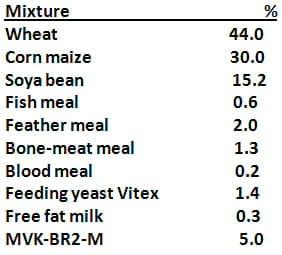
Vitamin program was as follows
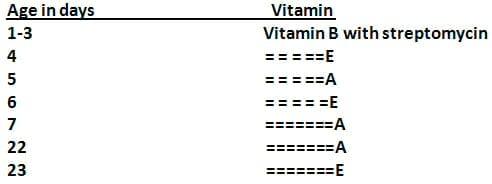
From 3 weeks age to the end of the experiment, vitamin AD3 and calcium diphosphate was added twice a week. The chicks were vaccinated at 18 days of age. Feed consumption was estimated weekly and the health condition was controlled daily. The lighting period was 24 hours from one to 14 days, this lighting period then decreased to reach 16 hours at the end of this experiment.
The temperature program was arranged under the recommendation of breeding organizations 1st week /33°C to reach 18°C at 8 weeks to the end of the experiment.
At the end of 5th week, and in every following week till the end of the experiment samples of 10 males and 10 females were slaughtered, eviscerated and studied for the determination of the abdominal fat and content of fatty acids in this fat.
The content of fatty acids in abdominal fat of broilers was determined by using the Soxhlet method with diethyl ether.
Notice: The most common fatty acids occurring in fats are
Saturated fatty acids: Lauric acid (C12:0), Myristic acid (C 14:0), Palmitic acid (C16:0) and Stearic acid (C18:0)Unsaturated fatty Acids: Palmitoleic acid (C16:1), Oleic acid (C18:1), Linoleic acid (C18:2) and Linolinec acid (18:3).
Results and discussion:
Dynamics of abdominal fat and fatty acids percentages in abdominal fat in relation to age and sex are shown in the table (1):
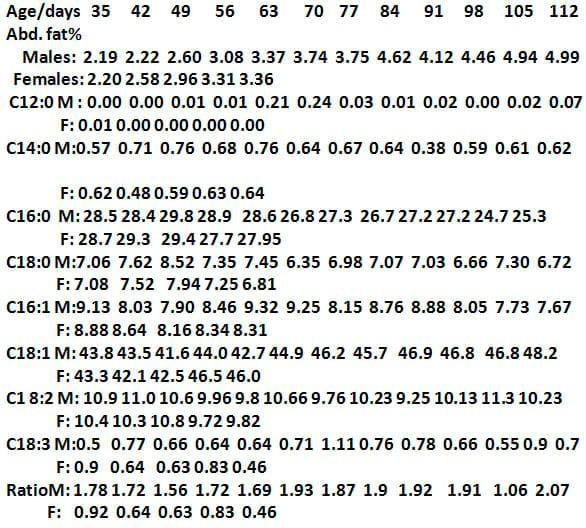
The tendency in abdominal fat showed a gradual increase in male broilers from 2.19% (5 weeks) to 4.99 % (16 weeks) and in females from 2.20% (5 weeks) to 3.36% (9 Weeks).This increase was gradual in both sexes. In males the tendency for saturated fatty acids showed that Lauric acid increased from 0.00% to 0.24% (10weeks) and thendecreased, Myristic acid increased from 0.57% (5 weeks) to 0.76% (9 weeks) and then decreased to 0.61% (15 weeks).
Palmitic acid showed an increase to 29.87% (7 weeks) then decreased and reach its minimum of 24.79% at 15 weeks. Stearic acid increase from 7.07% (5 weeks) to 8.52% (7 weeks) and then decreased.
With unsaturated fatty acids in males, the Palmitoleic,Oleic,Linoleic and Linolinec acids showed an unstable tendency with age, since the lowest values of these acids were 4.69% (16 weeks), 41.59% (7 weeks), 9.25% (14 weeks) and 0.5.% (5 weeks) resp.The corresponding highest values were 9.32% (7 weeks), 48.28% (16 weeks), 11.26% (15 weeks) and 0.98% (15 weeks) respectively for the above acids.
In females, the tendency of saturated fatty acids showed that the lowest values of Lauric, Myristic, Palmitic and Stearic acids were 0.00% (6-9 weeks) 0.78% (6 weeks) 27.67% (8weeks) and 6.81% (9 weeks) resp. The highest values were 0.011 % ( 5weeks), 0.64 % (9 weeks) 30.30 % (6 weeks) and 7.94% (7 weeks) resp.
The tendency of unsaturated fatty acids showed the following lowest values 7.67% (16 weeks), 41.59 % ( 9weeks), 9.25% (14 weeks) and 0.50% (5 weeks) resp, for the Palmitoleic, Oleic, Linoleic and Linolinec acids. The highest values were 9.32, 48.28, 10.95 and 0.92% at 9, 16,5and 5 weeks of age.
The ratio between unsaturated and saturated fatty acids in males decreased from 1.078 (5 weeks) to 1.56 (7 weeks) and then increased to its maximum of 2.06, 2.07 (15-16 weeks). In females this ratio decreased from 1.76 (5 weeks) to 1.60 (6 weeks), then increased to its maximum of 1.83 at 9 weeks of age.
Sex differences in the abdominal fat percentages and fatty acid percentages in the abdominal fat from 35 to 63 days of age are shown in the table 2:
Table 2: Effect of sex on the abdominal fat and fatty acids percentages of male and female chicks at 35-63 days of age:

No significant differences were observed in abdominal fat percentages between both sexes (35-63 days).
In saturated fatty acids, no significant differences were observed in Lauric and Stearic acids from 35 to 63 days of age between chicks of both sexes.Myristic and Palmitic acids showed significant differences (P +0.05) between males and females at 63 and 42 days of age.
The abdominal fat of male chicks was higher in Myristic acid by 0.12% and lower in Palmitic acid by 1.81% than the females at 63 and 42 days of age, while no significant differences were observed in Myristic and Palmitic acids in the other age categories.
In unsaturated fatty acids, no significant differences were observed in Palmitoleic, Linloleic and Linolinic acids at 35-63 days of age and in Oleic acid at 35-56 days of age between the abdominal fat of both sexes. A highly significant difference was observed in Oleic acid (P+ 0.01) between both sexes, i, e the abdominal fat of females was higher by 3.32% than that of the males at 63 days of age.
In the ratio between unsaturated and saturated fatty acids in the abdominal fat of male and female chicks, the only significant difference (P+0.05) was at 42 days of age, since the male broilers showed higher percentages (1.72) than females (1.61) at this age. No significant differences in the ratios were observed in the other age categories.
The significance in Myristic acid (63 days), Palmitic acid (42 days) and Oleic acid may be due to the fact that chicks of female sex finished their growth earlier than the males and deposited more abdominal fat, therefore, Oleic acid showed an increase with age from 42.35% to 46.02% at 63 days of age, while Palmitic and Stearic acids decreased again with females. This change in the fatty acid areas in the abdominal fat of females, also affected the ratio between saturated and unsaturated fatty acids, since this ratio decreased f4rom 1.76 (35 days) to 1.61% (42 days) and then increased to 1.83% (63 days), with males the situation was reverse.
Similar observations were made by Sauter and Seaman (1986), Griffith (1986) and Richard (1983) etc.
The quality of fatty was expressed by the ratio between unsaturated and saturated fatty acids. The unsaturated fatty acids from the nutritional point of view are more qualitative than the saturated ones, and more unsaturated fatty acids in the fat content, the more valuable products. From the point of view of storage, saturated fatty acids are preferable. Therefore, male broilers are better for storage because of the decrease in this ration with age from 1.78 at 5weeks to 1.69 at 9 weeks. From the nutritional point of view, females are better because of the increase in the unsaturated fatty acids with age.
The dependence of abdominal fat % and fatty acid % in abdominal fat (Y) on the age and on the live weight of chicks was expressed by linear and second degree parabolic equations as shown in table 3 and 4.
Table 3: Dependence of abdominal fat and fatty acids % on age of chicks'. Regression equation (Parabolic regression only for significant cases)
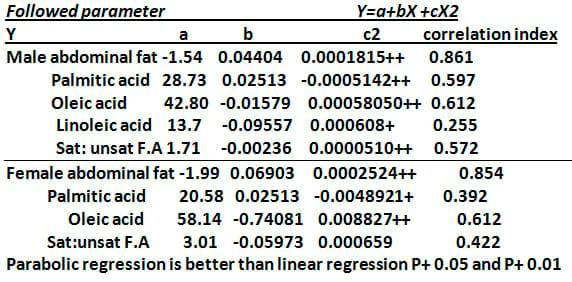
Table 4: Dependence of abdominal fat and fatty acid% on the live weight of chicks in grams –regression equations parabolic regression only for significant case.
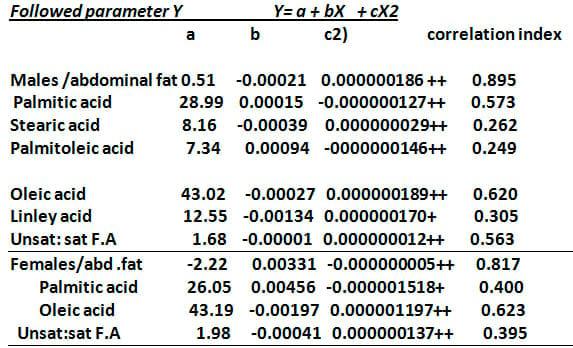
2) Parabolic regression is better than linear regression P +0.05, P +0.01 The abdominal fat % in male and female chicks was significantly affected by age. As age advanced, the abdominal fat % increased daily by 0.07072 and 0.09378 for males and females resp.
This dependence was expressed by linear equations but was better expressed (P + 0.01) by an an increasing portion of second degree parabolic equations.In the same direction, age affected significantly ( P+ 0.05 /0.01), the Palmitic, Stearic, Oleic acid % and in the ratio between unsaturated and saturated fatty acids in abdominal fat of males, and Palmitic, Oleic acids and the ratio unsaturated and saturated fatty acids in abdominal fat of females.
As age advanced ,Palmitic acid ,Stearic acid in males and Palmitic acid in females decreased daily by 0.05046 ,0.01088 and 0.06145 ,while Oleic acid and the ratio between unsaturated and saturated fatty acids increased by 0.06954 and 0.00515 for males and by 0.12431 and 0.00489 for females resp.
In males the dependence of Palmitic acid, Stearic acid and the ratio unsaturated: saturated were expressed by linear regressions but they were better expressed by a decreasing (Palmitic) and increasing (Oleic and ratio unsat: sat fatty acids) portion of parabolas.
Stearic acid was expressed only by a linear regression, while Linoleic acid was expressed by an increasing portion of second degree parabolic equation.
In females, this dependence was expressed by linear regression, but it was better expressed by an increasing portion of second degree parabolic equation.
Live weight highly significantly (P+ 0.01) affected the Palmitic, Stearic and Oleic acids and the ratio between unsaturated; saturated fatty acids in males, and in Palmitic, Oleic and Linoleic acids and the ratio unsaturated: saturated fatty acids (P+ 0.05 - 0.01).
With each gram of increase in live weight of males ,the Palmitic and Stearic acids decreased by 0.00074 and 0.00019, while Oleic acid and the ratio unsdaturated:saturated fatty acids increased by 0.00107 and 0.0008.This dependence was expressed by linear regression but was better expressed by a second degree parabolic equation. The dependence of Palmitic and Linoleic acids was expressed by (0.05) only by a second degree parabolic equation.
With females, the palmitic and Linoleic acids decreased by 0.00097 and 0.00064, Oleic acid and the ratio unsaturated; saturated fatty acids increased by 0.00239 and 0.00009 with each one gram in live weight of females.
The dependence of Palmitic, Oleic acids and the ratio unsaturated: saturated fatty acids were expressed by linear regression and even better by a second degree parabolicequation.The dependence of Linoleic acid were expressed only by linear regression.
Conclusion:
Generally it is possible from the organoleptic point of view to conclude that the quality of meat of males fattened to higher live weights and ages is preferable. The thigh and broth of males were significantly better. With respect to the % of fatty acids, male broilers were better for storage (more saturated fatty acids) and because of the decrease in the ratio between unsaturated and saturated fatty acids from 1.78 to 1.79.
References:
1-Chudy,J-Drozdowski,B.-Niewiadomski,b.J:Changes in fatty acid composition of depot fat in chickens.Rocz.Nauk roln.95: 99-107,1973
2-Edwards, H.M-Denman,F: Carcass composition studies –Influence of breed,sex,diet on gross composition of carcass and fatty acid composition of the adipose tissue. Poultry Sci.54:1230-1238.
3-Farrell, D.J: Effects of dietary energy concentrations on utilization of energy by broilers and on body composition determined by carcass analysis and predicated tritium.Brit.Poult.Sci .25:75-83, 1983.
4-Kubena,L.F-Deaton,J.W:Factors influencing the quantity of abdominal fat deposition in broilers I-Rearing,temperature,sex ,age or weight and dietary choline chloride and inositol supplementation .Poult.sci.53:211-214,12974.
5-Kubena, L.F –Reece, F.V.: Factors influencing the quantity of abdominal fat in broilers.Poult.Sci.53:974-978, 1974.
6-Leenstra, F.R.: Effect of age, sex, genotype and environment on fat deposition in broilers.>Wld.Poult.Sci.42:12-25.1986
7-Lin.C.Y.: Relationship between increased body weight and fat deposition in broilers.Wld.Poult.Sci37:106-110, 1980
8-Lohman.T.G: Biological variations in body composition .J.Anim.Sci 32:647-656.1983
9-Mandak.K.K –Skrivan, M.: Effect of energy content sin feed mixtures on fat deposition in broilers .Zivocis.vyr.30:359-365,1985
10-Sailer,K,Seemann.G.: neuere Versuchsergebnisse zur Broiler Langnost.Lohman Infom.5-6:5-8,1989
Related topics:
Authors:
Recommend
Comment
Share

Would you like to discuss another topic? Create a new post to engage with experts in the community.








.jpg&w=3840&q=75)